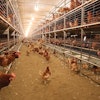The recent corn market commentary has been dominated by two themes, according to University of Illinois agricultural economist Darrel Good. One is that the U.S. Department of Agriculture's production estimate, to be released in January 2014, will be larger than the November forecast. The second is that corn consumption for ethanol production will be negatively impacted if the U.S. Environmental Protection Agency's preliminary rule making for the Renewable Fuels Standards (RFS) for 2014 is actually implemented. Good said that both of these expectations are questionable.
Production estimates
"Any change in the January corn production estimate from the November forecast would be the result of a change in either, or both, the estimate of acreage harvested for grain or the U.S. average yield," said Good. "The November National Agricultural Statistics Service (NASS) planted acreage estimate was fully consistent with the USDA's Farm Service Agency (FSA) report of planted acreage. Over the previous 10 years, the January U.S. average yield estimate was above the November yield forecast five times and below the forecast five times. Even in the five years when the November yield forecast exceeded the September forecast, as it did this year, the January estimate was below the November forecast twice. Considering the previous 30 years, the January yield estimate was above the November forecast 16 times and unchanged or lower 14 times," he said.
Good said that historically, the January corn production forecast was more heavily influenced by changes in acreage estimates than is currently the case because administrative data (primarily FSA-certified acreage data) were not fully incorporated in the NASS estimates until then. More recently, that data have been incorporated in the October production forecast (November in 2013). In the six years since 2003, in which the January production estimate exceeded the November forecast, the difference exceeded 80 million bushels of corn only in 2009 (230 million bushels). In the four years when the January production forecast was smaller than the November forecast, the difference ranged from 93 million to 210 million bushels.
Ethanol production
In preliminary rule making for 2014 announced on November 15, the EPA proposed to effectively reduce the mandate for renewable biofuels (primarily corn-based ethanol) in 2014 from the statutory requirement of 14.4 billion gallons to 13 billion gallons.
"Some have interpreted this to mean that, if implemented, the rules would result in less corn consumption for ethanol production during the current marketing year than would have otherwise occurred," said Good. "That may or may not be the case. Without a change in the rules, blending of ethanol in the domestic motor fuel supply during the 2013-2014 corn-marketing year would still have been limited by the 10 percent blend wall and consumption of relatively small quantities of higher blends. Domestic consumption would have been well short of 14.4 billion gallons and maybe less than 13.3 billion gallons.
"The proposed change in the RFS mandate does not necessarily substantially alter prospects for domestic ethanol consumption during the current corn-marketing year," said Good. "However, as pointed out two weeks ago, domestic ethanol consumption and production will be influenced by factors beyond the mandate. In particular, consumption will be influenced by the extent to which mandates are met with physical blending versus the use of Renewable Identification Numbers (RINs) stocks."
Ethanol production will also be influenced by changes in stocks of ethanol and by the magnitude and direction of net-ethanol trade, said Good. "With stocks at a four-year low, further reductions may be small," he said. "U.S. ethanol is also expected to experience a positive trade balance in the year ahead. Taken together, these factors suggest that prospects for corn consumption for ethanol production are still near the 4.9 billion bushels projected by the USDA."
Corn market functioning as needed
"Without a meaningful increase in the U.S. production estimate in January, corn prices appear low enough to encourage the increase in consumption made possible by the large 2013 crop," said Good. "U.S. corn is competitive in the world market, domestic livestock production has been returned to profitability, and ethanol production margins are large. As a result, export and export sales have accelerated, domestic livestock production is expanding, and ethanol production has rebounded. The corn market appears to be functioning as needed, with one exception: The large carry in the futures market price structure encourages carrying unneeded inventory into the next marketing year and also encourages producers to maintain large corn acreage in 2014."

















